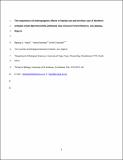Files in this item
The importance of anthropogenic effects in habitat use and territory size of Northern Anteater-chats Myrmecocichla aethiops near Amurum Forest Reserve, Jos-Plateau, Nigeria
Item metadata
| dc.contributor.author | Yadok, Biplang G. | |
| dc.contributor.author | Barshep, Yakhat | |
| dc.contributor.author | Cresswell, Will | |
| dc.date.accessioned | 2015-09-22T23:11:29Z | |
| dc.date.available | 2015-09-22T23:11:29Z | |
| dc.date.issued | 2014 | |
| dc.identifier | 138876735 | |
| dc.identifier | c20e9a78-4f3b-43ff-95f2-8f815cb62d85 | |
| dc.identifier | 84926172927 | |
| dc.identifier | 000345315300006 | |
| dc.identifier.citation | Yadok , B G , Barshep , Y & Cresswell , W 2014 , ' The importance of anthropogenic effects in habitat use and territory size of Northern Anteater-chats Myrmecocichla aethiops near Amurum Forest Reserve, Jos-Plateau, Nigeria ' , Ostrich , vol. 85 , no. 2 , pp. 147-151 . https://doi.org/10.2989/00306525.2014.957745 | en |
| dc.identifier.issn | 1727-947X | |
| dc.identifier.other | ORCID: /0000-0002-4684-7624/work/60426939 | |
| dc.identifier.uri | https://hdl.handle.net/10023/7526 | |
| dc.description.abstract | Occurrence of animals in an area and the size of territories they occupy is a function of resource availability and the environmental conditions in that area. Territory location in birds is often determined by availability of nesting habitat and we investigate whether this is the case for the little-studied Northern Anteater-chat Myrmecocichla aethiops. Territory size and location were mapped over two months in 2012 at 25 different sites where the birds occurred in central Nigeria and compared to 25 random sites where they did not, 500 m away. Vegetation variables, invertebrate abundance indicators, anthropogenic variables (availability of nest sites) and bird community components were measured and compared with adjoining areas (500 m away) from which the birds were absent in order to determine important factors determining territory location and size. Territories were 1.23 ha (SE 0.14) in size and were widely separated and so non-contiguous. Increasing numbers of abandoned wells, ant nests and termite mounds increased the probability of territory occupation. Territory size increased with the number of anteater-chats but decreased with increasing number of ant nests and overall bird diversity that were probably proxies for habitat quality. Overall, choice of preferred areas for the Northern Anteater-chat was centred on nesting sites and then habitat quality and group size probably determined territory size. | |
| dc.format.extent | 5 | |
| dc.format.extent | 273542 | |
| dc.language.iso | eng | |
| dc.relation.ispartof | Ostrich | en |
| dc.subject | Nesting habitat | en |
| dc.subject | Nigeria | en |
| dc.subject | Northern anteater-chat | en |
| dc.subject | Termite mounds | en |
| dc.subject | Territory size | en |
| dc.subject | QH301 Biology | en |
| dc.subject.lcc | QH301 | en |
| dc.title | The importance of anthropogenic effects in habitat use and territory size of Northern Anteater-chats Myrmecocichla aethiops near Amurum Forest Reserve, Jos-Plateau, Nigeria | en |
| dc.type | Journal article | en |
| dc.contributor.institution | University of St Andrews. School of Biology | en |
| dc.contributor.institution | University of St Andrews. Scottish Oceans Institute | en |
| dc.contributor.institution | University of St Andrews. Institute of Behavioural and Neural Sciences | en |
| dc.contributor.institution | University of St Andrews. St Andrews Sustainability Institute | en |
| dc.contributor.institution | University of St Andrews. Centre for Biological Diversity | en |
| dc.identifier.doi | 10.2989/00306525.2014.957745 | |
| dc.description.status | Peer reviewed | en |
| dc.date.embargoedUntil | 2015-01-01 |
This item appears in the following Collection(s)
Items in the St Andrews Research Repository are protected by copyright, with all rights reserved, unless otherwise indicated.

